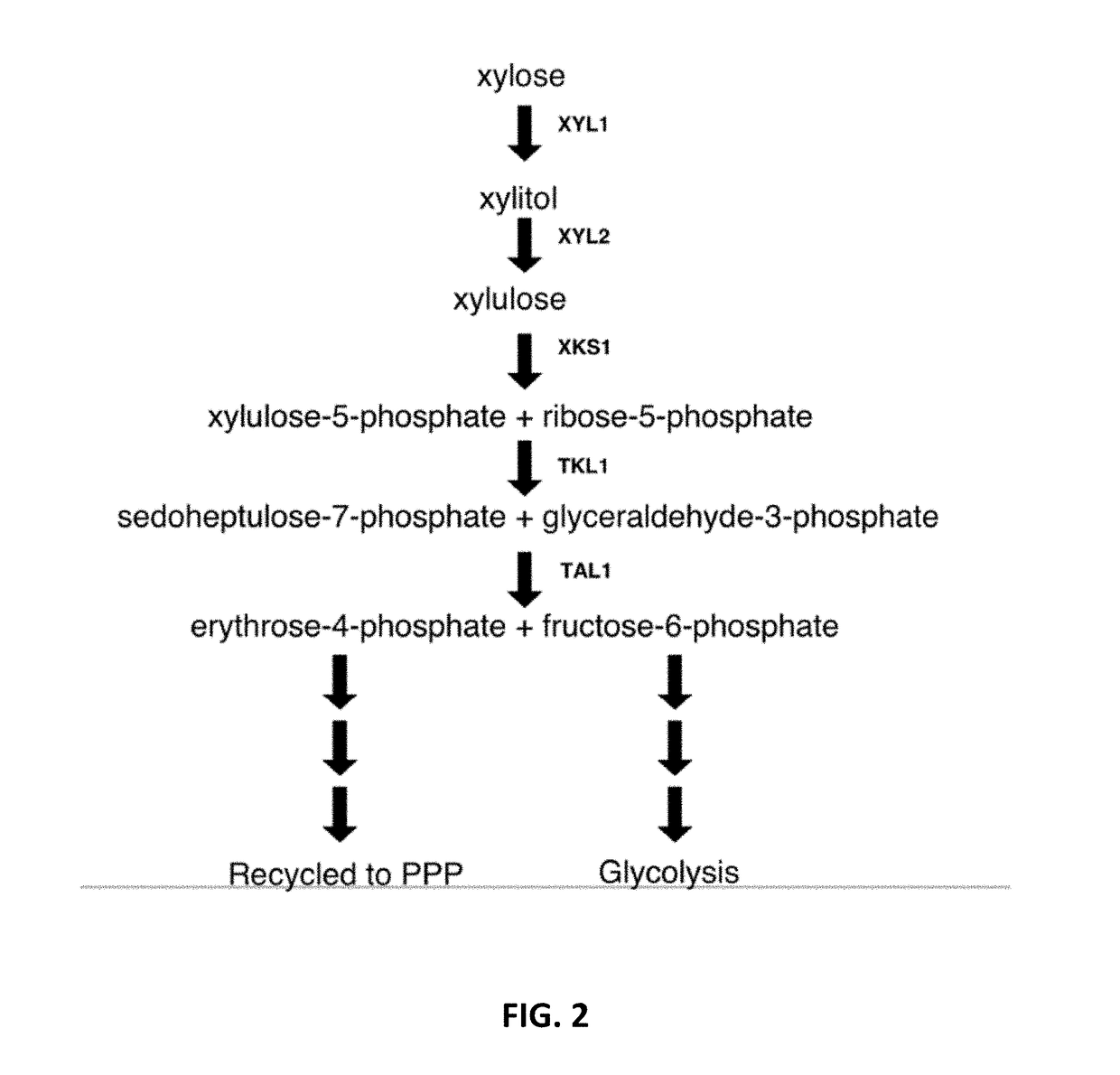Methods and organism with increased ethanol production
a technology of ethanol production and methods, applied in the field of molecular biology and microbiology, can solve the problems of low value of ethanol, limited ethanol production from xylose, and high cost of raw materials, and achieve the effect of enhancing xylose uptake or metabolism
- Summary
- Abstract
- Description
- Claims
- Application Information
AI Technical Summary
Benefits of technology
Problems solved by technology
Method used
Image
Examples
example i
Engineering S. cerevisiae with Enhanced Xylose Uptake
[0243]S. cerevisiae does not have the functional machinery to efficiently utilize xylose as the carbon source. S. cerevisiae has a fully annotated genome, complete transcriptomic data and hundreds of tools developed for genetic and biochemical manipulation. The xylose transporters from the H0 Metschnikowia species were introduced to S. cerevisiae to increase xylose uptake and to synthesize bioderived product from renewable biomass. S. cerevisiae BY4742 was used as the genetic platform to heterologously over-express xylose transporter from the H0 Metschnikowia species.
[0244]The following xylose transporters from the H0 Metschnikowia species were cloned XYT1, GXF1, ΔGXF1 (encoding variant of GXF1 with shorter N-terminus), GXS1 / HGT12, ΔGXS1 / HGT12 (encoding variant of GXS1 / HGT12 with shorter N-terminus), and HXT5, and codon optimized for expression in S. cerevisiae. As shown in FIG. 3, the expression of XYT1 in Saccharomyces, the xylo...
example ii
Engineering S. cerevisiae with Enhanced Xylose Metabolism
[0249]A shown in FIG. 2, The xylose metabolism pathway including Xyl1p, Xyl2p and Xks1p converts xylose for use by the pentose metabolism pathway. Briefly, Xyl1p converts xylose to xylitol; Xyl2p converts the latter to xylulose; and Xks1p converts xylulose to xylulose-5-phosphate. This process allows xylose direct entry into the pentose phosphate pathway and eventually the tricarboxylic acid cycle. Each of the H0 gene products synthesized for S. cerevisiae: Xyl1p, Xyl2p, Xks1p.
[0250]Each of the xylose metabolism genes were cloned from the H0 Metschnikowia species. Similar to the transporters described above, each gene was synthesized with S. cerevisiae codon optimization. The H0 XYL1, XYL2 and XKS1 ORFs were expressed in S. cerevisiae from the promoters of ScTDH3, ScCPS1, and AgTEF2, respectively.
example iii
Engineering S. cerevisiae with Further Enhanced Xylose Metabolism
[0251]The S. cerevisiae pentose metabolism primarily functions to supply reducing energy and riboses for nucleotide synthesis. Deletion of phosphatase gene PHO13 can induce upregulation of xylose metabolism genes derepression of transaldolase (TAL1). CRISPR-Cas9 was used to delete the PHO13 gene (Xu et al., 2016). CCW12 promoter was also introduced to express ScTAL1 to further enhance the xylose metabolism in the pho13 deletion mutant.
PUM
| Property | Measurement | Unit |
|---|---|---|
| Molar mass | aaaaa | aaaaa |
| volumes | aaaaa | aaaaa |
| temperature | aaaaa | aaaaa |
Abstract
Description
Claims
Application Information
 Login to View More
Login to View More - R&D
- Intellectual Property
- Life Sciences
- Materials
- Tech Scout
- Unparalleled Data Quality
- Higher Quality Content
- 60% Fewer Hallucinations
Browse by: Latest US Patents, China's latest patents, Technical Efficacy Thesaurus, Application Domain, Technology Topic, Popular Technical Reports.
© 2025 PatSnap. All rights reserved.Legal|Privacy policy|Modern Slavery Act Transparency Statement|Sitemap|About US| Contact US: help@patsnap.com



